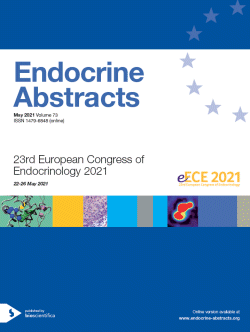
European Congress of Endocrinology 2021
Online
22 May 2021 - 26 May 2021
Oral Communications
Oral Communications 9: Endocrine-Related Cancer
ea0073oc9.1 | Oral Communications 9: Endocrine-Related Cancer | ECE2021
Thymic neuroendocrine tumor and mortality in MEN 1 patients: the spanish registry
Casteras Anna , Valdés Nuria , Lamas Cristina , Gaztambide Sonia , Paja Fano Miguel , Navarro Elena , Álvarez Escol Cristina , Diego Estrella , Calatayud María , Segura Pedro , Oriola Josep , Spanish group for the study of MEN and PPGL
ea0073oc9.2 | Oral Communications 9: Endocrine-Related Cancer | ECE2021
Utility of In1-ghrelin as a novel non-invasive diagnostic and prognostic biomarker of prostate cancer in patients with PSA in the grey-zone
Montero-Hidalgo Antonio J. , Herrero-Aguayo Antonio J. , Enrique Gómez-Gómez , Guler Ipek , Justo P. Castaño , Sarmento-Cabral André , Gahete Ortiz Manuel , Luque Raul M , Jiménez Vacas Juan Manuel
ea0073oc9.3 | Oral Communications 9: Endocrine-Related Cancer | ECE2021
Dysregulation of alternative splicing unveils new avenues for targeting pulmonary carcinoids
Blázquez-Encinas Ricardo , Teresa Caro María , García-Vioque Víctor , Pedraza-Arévalo Sergio , Alors-Pérez Emilia , Dulcínea Herrera-Martínez Aura , Sánchez-Sánchez Rafael , Serrano-Blanch Raquel , Foll Matthieu , Fernández-Cuesta Lynnette , D Gahete Manuel , M Luque Raúl , Ibáñez-Costa Alejandro , P Castaño Justo
ea0073oc9.4 | Oral Communications 9: Endocrine-Related Cancer | ECE2021
Splicing machinery landscape is dysregulated in chronic liver disease: central role of EIF4A3 in hepatocarcinogenesis.
López-Cánovas Juan Luis , Hermán-Sánchez Natalia , Moreno-Montilla María T , del Rio-Moreno Mercedes , Sánchez-Frias Marina E. , Amado Víctor , Ciria Rubén , Briceño Javier , de la Mata Manuel , Castaño Justo P. , Rodriguez-Perálvarez Manuel , Luque Raul M , Gahete Ortiz Manuel
ea0073oc9.5 | Oral Communications 9: Endocrine-Related Cancer | ECE2021
Reassessment of the diagnostic criteria of insulinoma: A retrospective monocentric cohort study of 72-h fasting trial in 124 patients
Fideline Bonnet , Devingenteuil Clara , Vaczlavik Anna , Bessiene Laura , Laguillier-Morizot Christelle , Assié Guillaume , Helen Mosnier-Pudar , Terris Benoît , Groussin Lionel , Guibourdenche Jean , Bertherat Jerome
ea0073oc9.6 | Oral Communications 9: Endocrine-Related Cancer | ECE2021
Presence and pathophysiological role of sst5TMD4, an aberrant spliced variant of the somatostatin receptor subtype 5, in human high-grade astrocytomas
Garcia Garcia Miguel , Fuentes-Fayos Antonio C. , Blanco-Acevedo Cristobal , Solivera Juan , Gahete Ortiz Manuel , Castaño Justo P. , Luque Raul M.



